Wild Food of Spring: A Foraging Guide
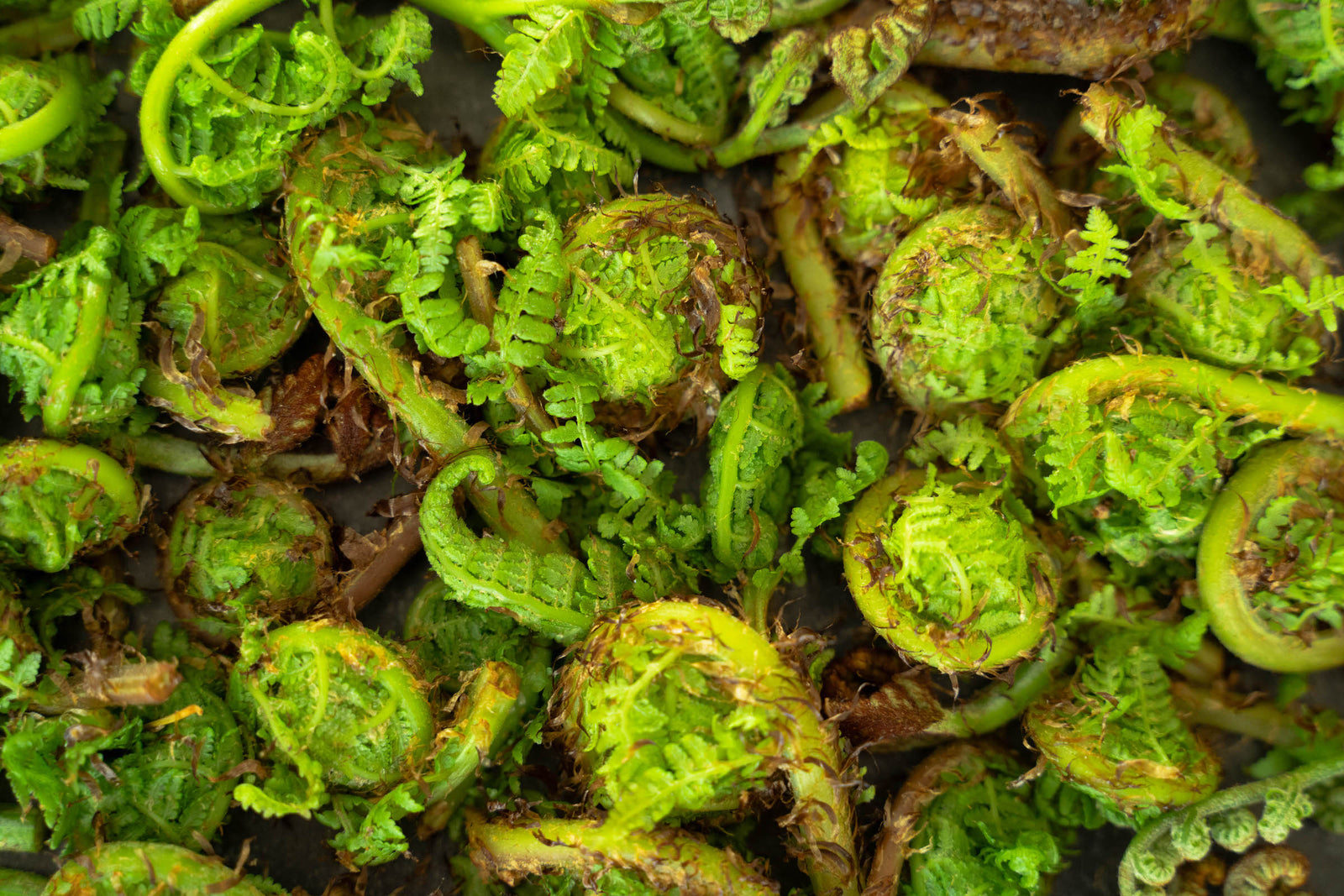
Spring is a time for fresh tender greens, wildflowers, and the first mushrooms of the season. It’s a fabulous time of year to start reconnecting with nature, hit the trail, and hunt for some wild edibles!
As nature starts to wake up after its winter slumber, many plants produce edible leaves, flowers, and fruits as they finally start to put out new growth again. If you love discovering new food, experimenting in the kitchen, and getting outside, try to find some of these delicious wild foods.
Note: As with any foraging or wildcrafting, make sure you can positively identify plants and avoid harvesting from polluted or contaminated areas. If you're unsure about a plant's identification or safety, seek guidance from an experienced forager or botanist.
Here are 9 common, easy-to-identify wild spring edibles to look out for:
1. Miner’s Lettuce
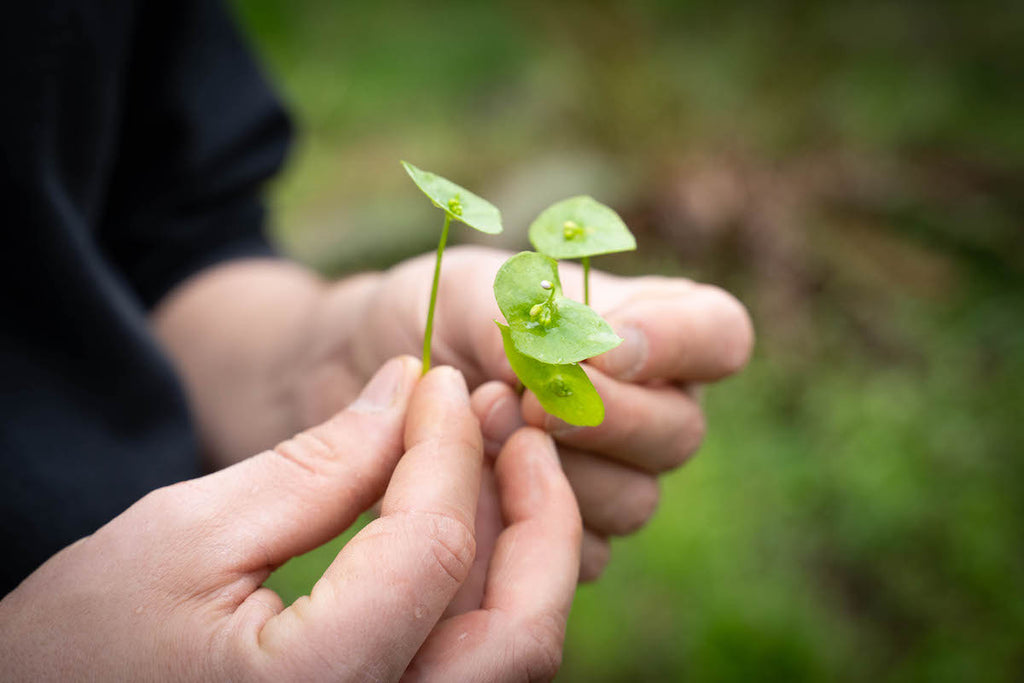
Miner’s lettuce, Claytonia perfoliata, is an ubiquitous wild salad green that is crunchy, earthy, and honestly quite adorable. It grows abundantly in many wild as well as urban areas, is loaded with vitamin C, and deserves its place on your table.
How to identify miner’s lettuce:
You can recognize miner’s lettuce by its heart-shaped leaves that turn into little cups as it matures. At full maturity, these saucer-like leaves contain clusters of tiny white flowers springing forth from their centers. It’s a small plant that likely won’t reach more than a few inches off the ground and it has a tendency to spread in the cool, moist areas that it prefers.
Miner’s lettuce doesn’t have any known poisonous look-alikes, making it a great plant for beginning foragers.
Consuming miner’s lettuce:
The best and most obvious use of miner’s lettuce is to add it to salads. The leaves are fresh and delicious raw and there’s really no reason to cook it. It’s lovely dressed with a citrusy vinaigrette. Sprinkle some on a pizza after it comes out of the oven, dot some on top of crostini, or use as an edible garnish on spring plates.
2. Magnolia Flowers

The magnolia tree (Magnolia grandiflora) is one of the very first to bloom in the spring, with big showy fragrant flowers that open before there’s a single leaf on a branch. Their smell is similar to lilacs, and their petals have a distinct ginger flavor.
How to identify magnolia flowers:
There are over 125 types of magnolia trees, with flowers that range in color. The most common varieties have large white or pink flowers with distinct petals shaped almost like a tulip. The leaves of the tree are typically shiny, deep green, and oval shaped.
Once you’ve seen the flowers, they’re hard to miss. The bright magenta or creamy white blooms can be as large as your hand and give off a lovely scent.
Consuming magnolia flowers:
Because of their gingery flavor, magnolia flowers lend themselves well to desserts and beverages. You can easily make a simple syrup with them by simmering equal parts sugar, water, and magnolia petals together. Allow to steep for at least 10 minutes before straining out the petals, and you’ll have a ginger-infused syrup to use in drinks or on desserts.
Another very common usage for the petals is to pickle them. Pickled magnolia flowers taste similar to sushi ginger and can be used in a similar fashion.
3. Nettles
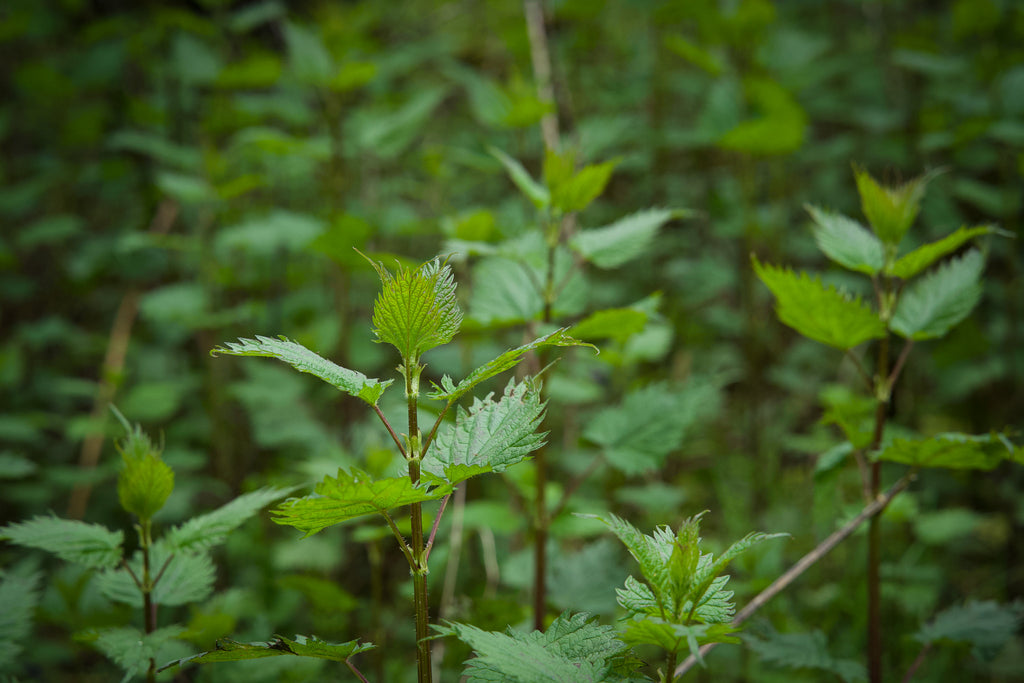
Nettles (Urtica dioica) are a fun herb to add to your foraging arsenal. They’re packed full of nutrition and are a favorite among herbalists for their healing properties, but watch out – they bite. Stinging nettles get their name because they’re covered in tiny hairs that are filled with histamine and other acids that break on contact, injecting these chemicals into whoever bumps into them.
However, these special plants are high in amino acids, iron, calcium, potassium, zinc, and vitamins A and C. They’re also known for their ability to help fight allergies and ease the pain of arthritis. In essence, they’re worth the risk to harvest!
How to identify nettles:
This unique plant is easy to identify. Nettle leaves are typically lance-shaped with a pointed tip and serrated edges. The leaves are a vibrant dark green color and can grow to be several inches long. They’re covered in tiny, stinging hairs on the stems and leaves of the plant.
Nettle plants produce tiny white, green,or purple flowers in clusters underneath the leaves that bloom in late spring to early summer. It’s best to harvest nettle leaves before they flower, because they start to produce higher amounts of calcium oxalate, which causes a bitter flavor and can be hard on your kidneys.
Look for stinging nettles in wooded areas with moist, nutrient-rich soil, and along riverbanks and creeks.
Consuming nettles:
Nettles need to be prepared with a bit of care. Be careful when harvesting and handling nettles before they’re cooked and always wear gloves. If they touch your bare skin, you will definitely feel it.
The best way to make use of stinging nettles is to blanch them in boiling water for a minute or two (use tongs!) and then place them in an ice bath to stop cooking. Once strained, use the blanched nettles as you would spinach. They’re especially delicious in pesto, pasta, and in Indian dishes as a spinach substitute.
4. Morels
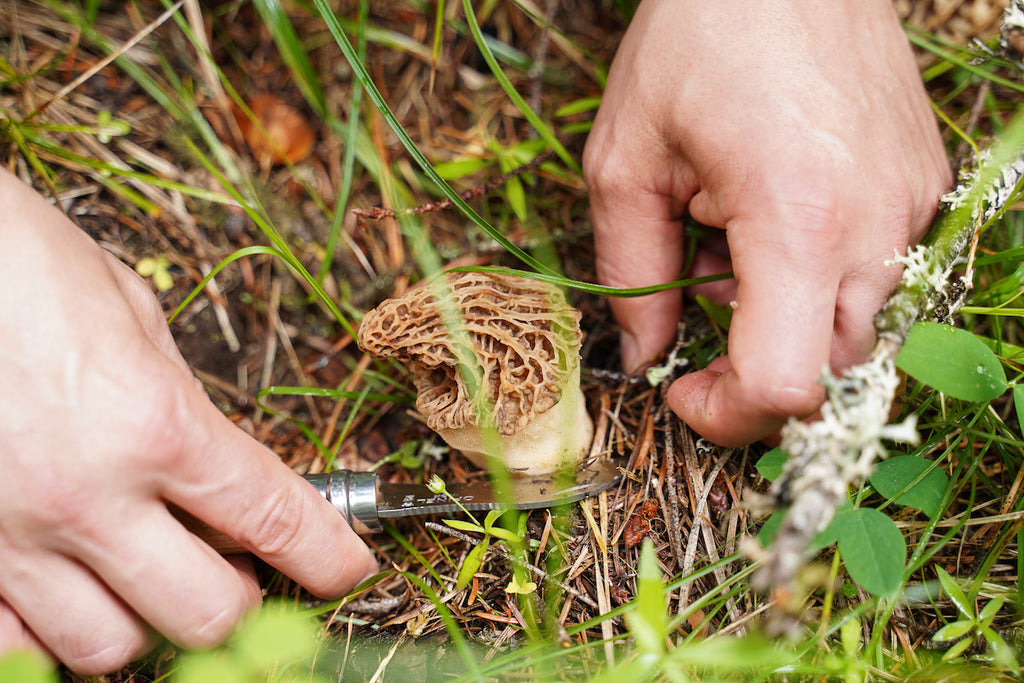
Notoriously difficult to find but equally delicious, morel mushrooms (Morchella spp) are a forager’s delight. These unique-looking mushrooms only pop up in the spring and are somewhat mysterious in terms of their growing preferences. Morels are often found in burn areas in the years following a wildfire, as well as recently landscaped areas and other disturbed zones. Of course, they also grow in forested habitats.
How to identify morel mushrooms:
Although there is a mushroom commonly referred to as “false morel”, this mushroom doesn’t have any real look-alikes. You can recognize it by its perforated honeycomb surface and hollow body. True morels are completely hollow, from the stem all the way up to the cap.
The caps of morel mushrooms are typically elongated or cone-shaped and are attached directly to the stem. Blonde morels have pale ridges with dark pits, and black or “burn morels” have dark ridges with lighter pits. There are at least a dozen species of morels, so study them and get to know their features well before mushroom hunting.
Eating morels:
As with almost all mushrooms, morels should be thoroughly cooked before eating. They’re delicious roasted on the grill, sauteed in a pan with butter and garlic, or added to risotto. They also make a great candidate for stuffed mushrooms, as their hollow nature allows them to easily be filled if sliced in half lengthwise.
5. Porcini

Spring porcini (Boletus rex-veris), also known as the spring king, are a favorite among mushroom hunters. Their dense meaty texture and savory umami flavor make them a highly desirable wild food.
Porcinci is Italian for “little pig”, a name that suits the rounded, stumpy appearance of these popular mushrooms. They’re renowned for their excellent flavor and sought out by the finest chefs across the world. The mushrooms are best if you can find them as they’re just popping out of the ground. Older mushrooms tend to be bug-ridden and become spongy with age.
How to identify porcini mushrooms:
As a member of the bolete family, porcini have a spongy layer of fine pores under the cap instead of gills. Their cap is slightly lumpy and dark reddish brown in color. The bulbous shape of their stem is very distinct, sometimes as thick as the cap is wide.
Look for them in conifer forests at elevations of a few thousand feet as soon as temperatures begin to warm in the spring. Be sure to test their spore layer for bruising - if they stain blue, they’re not the boletes you’re looking for.
Eating porcini:
The porcini mushroom is excellent cooked fresh, but it also can be dehydrated and/or powdered to extend its shelf life. Use fresh mushrooms as you would a nice steak – pan fried with butter and garlic, sliced thin and served on top of pasta, risotto, salad, or soup.
Dried porcini can be added to soups, rehydrated for use in recipes, or ground into a savory powder. We also like to use dried porcini to make mushroom stock, a versatile ingredient to have on hand for all kinds of recipes.
6. Salmonberries
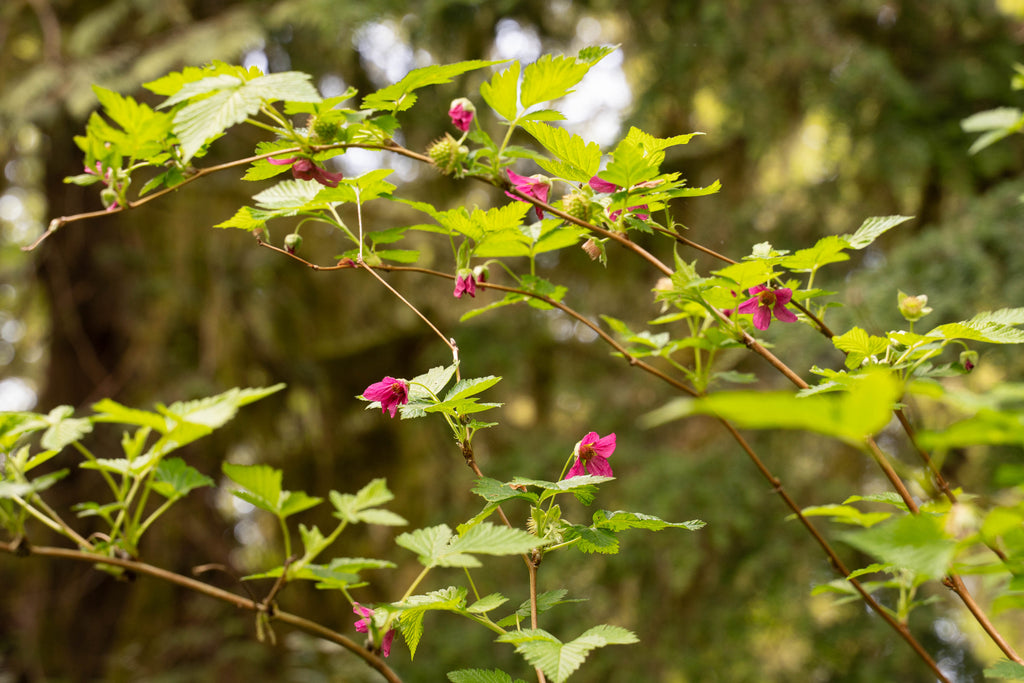
Unlike most berries, which ripen in the hot days of summer, salmonberries develop their sunny golden fruits in mid- to late spring. They’re an important food for wildlife, as they pop up at the end of the long winter, when other food sources are scarce.
Salmonberries (Rubus spectabilis) are a member of the same family as raspberries, noticeable from the similar appearance of their fruits. The sturdy berries have a tart flavor that can be quite sour at first, but they get sweeter as they ripen.
How to identify salmonberries:
Salmonberry plants grow in moist forests from southeast Alaska to the northern coast of California in large, sprawling brambles. They put off small five-petaled magenta flowers that develop berries ranging from light yellow to deep orange-red.
Look for tall brown canes that grow in thickets, with alternate serrated leaves. The bright flowers are easy to recognize once you get familiar with them. Their berries are similar in size and shape to a raspberry, but are lighter in color and firmer in texture.
Consuming salmonberries:
You can enjoy fresh salmonberries straight off the bush or use them in recipes and preserves. They’re great thrown into muffin or pancake batter and are a perfect candidate for jams and jellies. Alternatively, you can use them in desserts as a replacement for other similar berries.
7. Fiddleheads
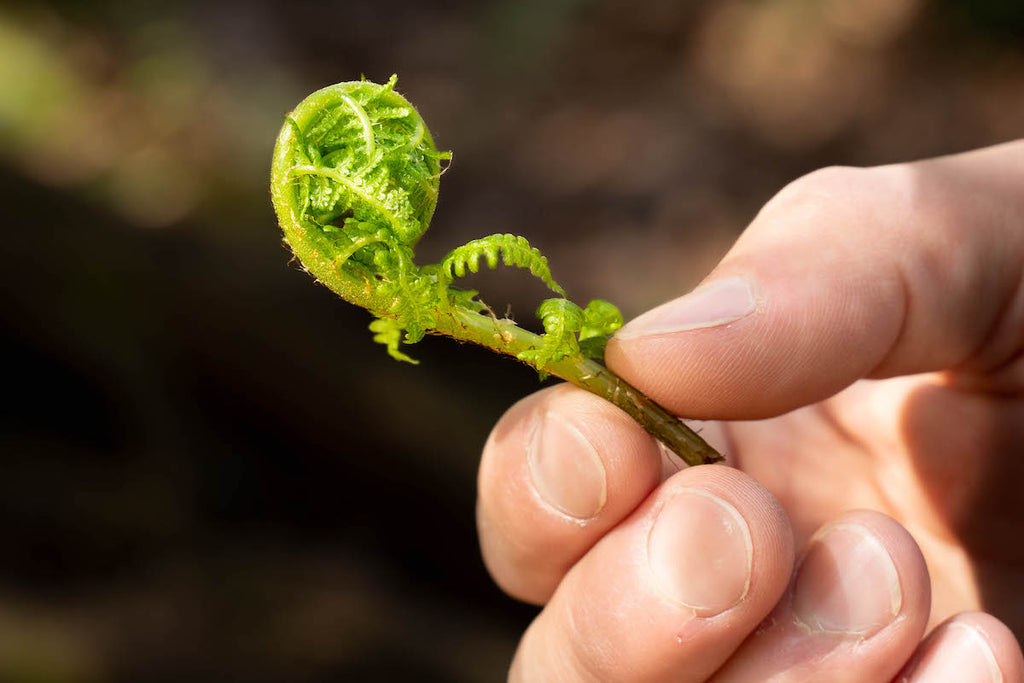
There is perhaps no wild food more adorable than the fiddlehead. The perfect, bright green spirals are the beginning of young ferns unfurling in the spring. Because they can only be eaten while they’re still tightly coiled, their harvest window is very short indeed.
There are two main types of ferns from which fiddleheads can be harvested and consumed. The ostrich fern (Matteuccia struthiopteris) grows primarily in the eastern and northern states, while lady ferns (Athyrium filix-femina) are the sweetheart of the Pacific Northwest.
How to identify fiddleheads:
To properly identify fiddleheads, you need to get to know your ferns. There are many types of ferns, and nearly all of them produce fiddleheads in the early spring. But, only a few of them are considered edible.
One of the main identifying factors of the ostrich fern is the deep U-shaped groove on the inside of their stem. Another clue is the papery brown scales that typically cover the uncoiled fiddleheads.
Lady ferns also have a similar groove inside the stem. The fiddleheads are covered in small hairs, reminiscent of orangutan fur, that can easily be rubbed off with the fingers. The ferns have soft and frilly lime green leaves.
Eating fiddleheads:
For both ostrich and lady ferns, be sure to harvest them while they’re still tightly coiled. If they’ve begun unfurling, leave them be. Perfect fiddleheads can be easily snapped from their base with your fingers.
In the kitchen, use fiddlehead ferns like your favorite green vegetable. They’re similar in taste and texture to green beans or asparagus, but they have a flavor and personality all their own.
Have some patience when cleaning fiddleheads. It takes a while to rub off all the tiny orangutan-like hairs, but it’s worth the trouble. It’s best to give them a quick one or two minute blanch first, then throw them into a pasta dish, soup, or use as a side veggie.
8. Spruce & Fir Tips
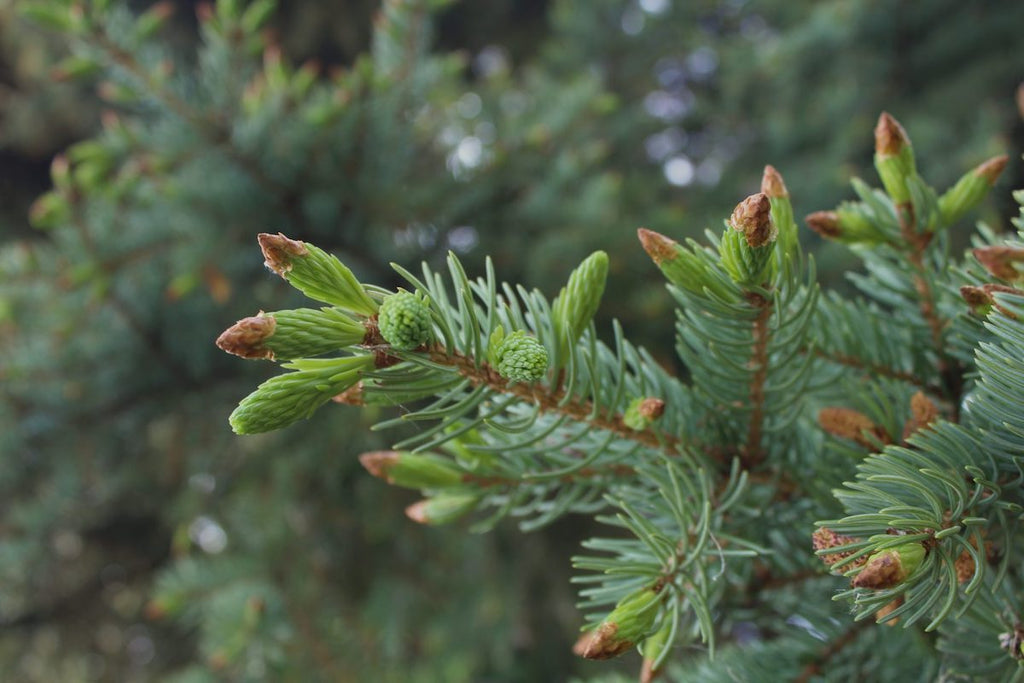
Every spring, spruce and fir trees put off fresh new growth from the tips of their branches. Unlike the older needles, this new growth is super soft and tender. And, of course, it’s edible!
The flavor profile of spruce and fir tips can vary from tree to tree, so be sure to try several different trees until you find one with a flavor you enjoy. The taste can range from citrusy to bitter, from downright resiny to delightfully floral.
How to identify spruce tips:
Learn how to identify the varieties of spruce and fir trees in your area. Look for specific qualities in their needles, bark, and pinecones to help with identification. The beautiful bright chartreuse tips stand out proudly against the backdrop of dark green trees.
Consuming spruce tips:
While you can eat spruce tips straight from the branch, you’ll probably find it more enjoyable to use them in your cooking. Think of them like a fresh herb, and find creative ideas to infuse their flavor into a sauce, syrup, or sugar.
As spruce tips taste citrusy and herbaceous, they’re great for both sweet and savory dishes. Use them in a sauce to complement rich meats, or sprinkle spruce tip sugar onto berry desserts.
9. Dandelion Flowers & Greens
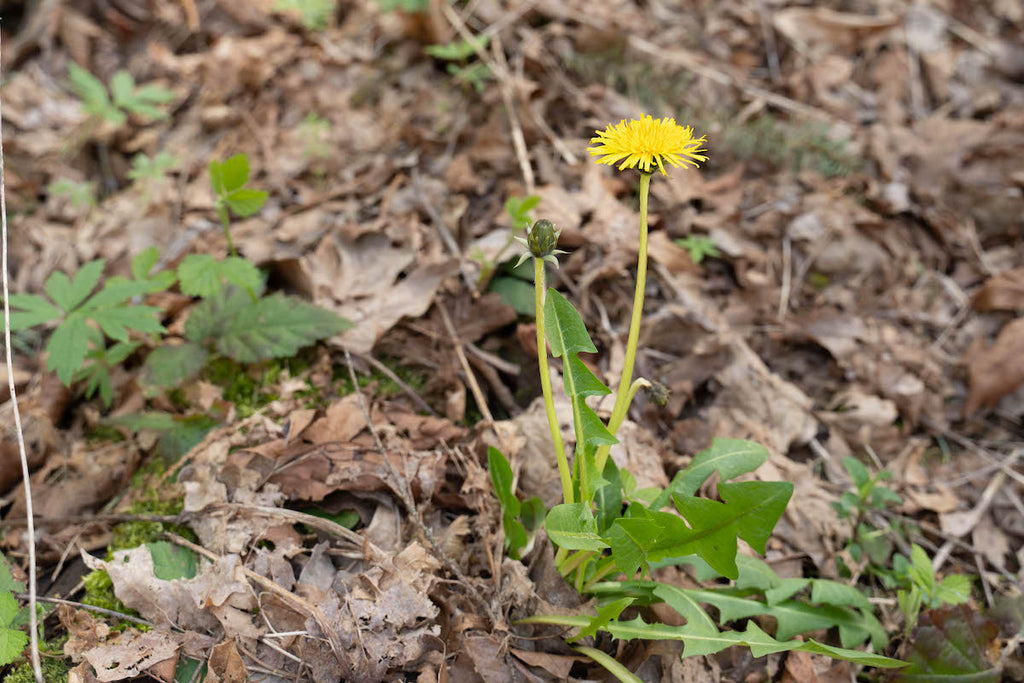
Here’s a wild food just about everyone is familiar with - but not everyone realizes that they’re edible. They’re also great for you! You can eat both the flowers and the leaves of dandelion (Taraxacum officinale) plants, as well as their roots. Talk about a useful weed!
How to identify dandelions:
Most people can identify dandelions, but did you know they have a few sneaky lookalikes? Luckily, even their doppelgangers are edible.
Dandelions have deeply saw toothed leaves that excrete a milky latex when broken.
They have bright yellow sunny flowers that grow on single, hollow stems. Their main lookalikes, cat’s ear and sow thistle, have very similar flowers but they grow on stems that are branching and not hollow.
Eating dandelion flowers & greens:
Enjoy dandelion flowers in desserts, as they taste similar to honey. To use them in your bakes, you can make a dandelion sugar, a simple syrup, or throw the petals straight into cake batter.
Even though you’ll lose some of the pollen, you should still always wash dandelion flowers! Try to harvest them from a place away from busy roads, pets, and pesticide use.
Dandelion greens have a bitter, peppery taste similar to arugula. If you enjoy bitter greens, they can be chopped up and added raw to salads. Cooking will soften their bitterness a bit, and they can be cooked up just like any other green you might use, like spinach or kale. They’re an excellent source of vitamins A, C, E, and K and are also high in iron, so eat up!
Spring is truly one of the best times to harvest wild food. This list is only a small taste of the delicious and nutritious wild edibles you can try at this time of year. More of our favorite spring finds include oyster mushrooms, purslane, chickweed, clover, wild violets, and Nootka roses.
If you like foraging, educate yourself about what else grows in your area during the spring. Learn important identification techniques, find clean sources away from pollution, and get out there in nature and have fun. You might discover a new food you love.
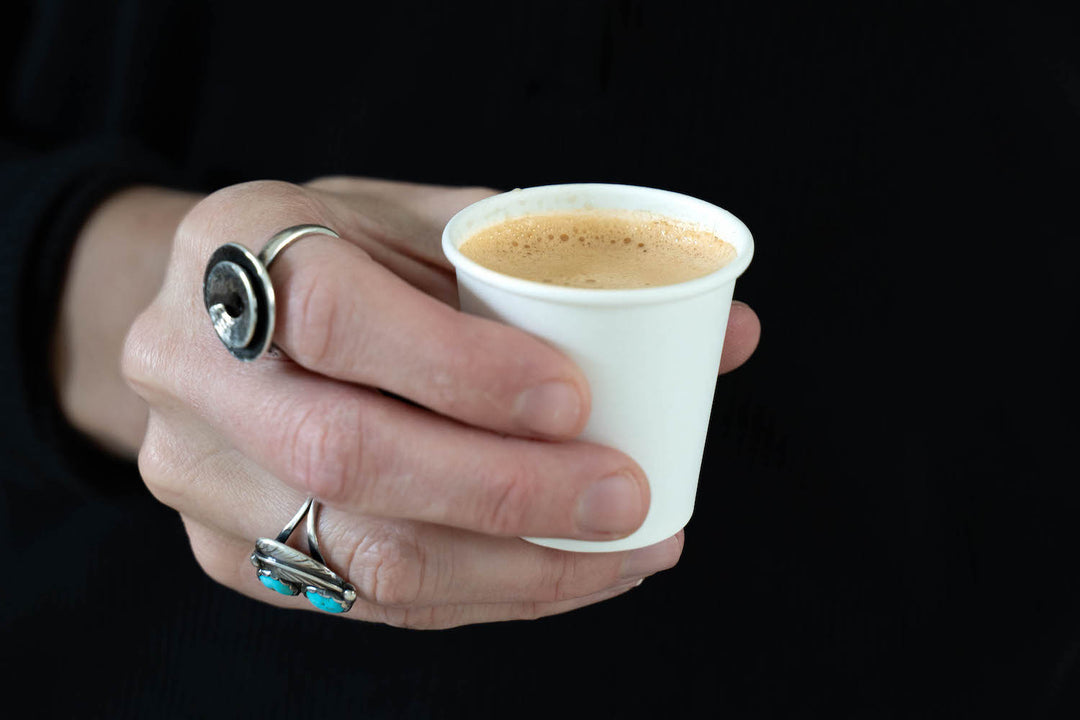


Leave a comment